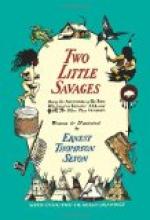Yet two other social grades existed. Every man and boy in Sanger was an expert with the axe; was wonderfully adroit. The familiar phrase, “He’s a good man,” had two accepted meanings: If obviously applied to a settler during the regular Saturday night Irish row in the little town of Downey’s Dump, it meant he was an able man with his fists; but if to his home life on the farm, it implied that he was unusually dexterous with the axe. A man who fell below standard was despised. Since the houses of hewn logs were made by their owners, they reflected the axemen’s skill. There were two styles of log architecture; the shanty with corners criss-cross, called hog-pen finish, and the other, the house with the corners neatly finished, called dovetail finish. In Sanger it was a social black eye to live in a house of the first kind. The residents were considered “scrubs” or “riff-raff” by those whose superior axemanship had provided the more neatly finished dwelling. A later division crept in among the “dovetailers” themselves when a brickyard was opened. The more prosperous settlers put up neat little brick houses. To the surprise of all, one Phil O’Leary, a poor but prolific Dogan, leaped at once from a hog-pen log to a fine brick, and caused no end of perplexity to the ruling society queens, simply paralyzing the social register, since his nine fat daughters now had claims with the best. Many, however, whose brick houses were but five years old, denounced the O’Learys as upstarts and for long witheld all social recognition. William Raften, as the most prosperous man in the community, was first to appear in red bricks. His implacable enemy, Char-less (two syllables) Boyle, egged on by his wife, now also took the red brick plunge, though he dispensed with masons and laid the bricks himself, with the help of his seventeen sons. These two men, though Orangemen both, were deadly enemies, as the wives were social rivals. Raften was the stronger and richer man, but Boyle, whose father had paid his own steerage rate, knew all about Raften’s father, and always wound up any discussion by hurling in Raften’s teeth: “Don’t talk to me, ye upstart. Everybody knows ye are nothing but a Emmy Grant.” This was the one fly in the Raften ointment. No use denying it. His father had accepted a free passage, true, and Boyle had received a free homestead, but what of that—that counted for nothing. Old Boyle had been a “PASSENGER,” old Raften an “EMMY GRANT.”
This was the new community that Yan had entered, and the words Dogan and Prattison, “green” and “orange and blue,” began to loom large, along with the ideas and animosities they stood for.
The accent of the Sangerite was mixed. First, there was a rich Irish brogue with many Irish words; this belonged chiefly to the old folks. The Irish of such men as Raften was quite evident in their speech, but not strong enough to warrant the accepted Irish spelling of books, except when the speaker was greatly excited. The young generation had almost no Irish accent, but all had sifted down to the peculiar burring nasal whine of the backwoods Canadian.




